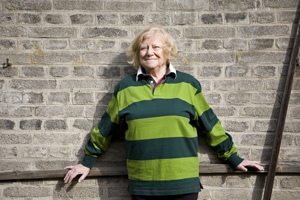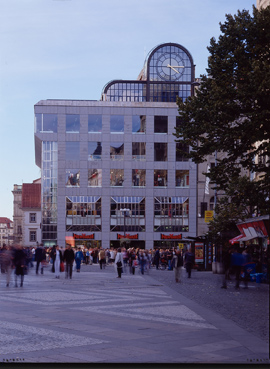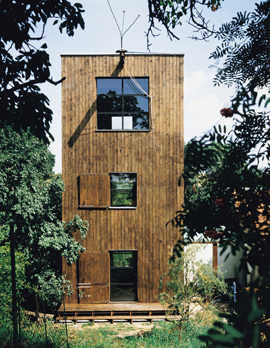
Post ČKA 2007: Alena Šrámková
The award of the Czech Chamber of Architects is granted annually to individuals in the field who have made a significant mark on the modern history of Czech architecture with their work and moral approach.
 |
| photo Jan Kuděj |
In 1996, Alena Šrámková had a comprehensive exhibition of her architectural work at the Jaroslav Fragner Gallery, where the dominant piece, albeit of a more intimate nature, was a tower for a scientist (realized in 1994). We could pause for a moment at that one, as this seemingly simple, unusual vertical wooden structure represented a kind of manifesto, at that time the last word of the architect, a pregnant statement about her approach to architectural creation in general. Earlier, she participated in significant public construction projects, such as the reconstruction and expansion of the Main Train Station in Prague (in collaboration with Jan Šrámek, Jan Bočan, Josef Danda, 1977), and before that the building of the then ČKD in Prague Na Můstku (together with Jan Šrámek, 1983), which was then considered by the younger Prague generation as the first swallow of architectural renewal amid the sterile atmosphere spreading in the gray zone of socialist construction. The tower was also preceded by strong inspiration: in 1991, an exhibition of the American architect, educator, and poetic theorist John Hejduk took place in Prague, a person who managed in a wonderful way to penetrate elementary forms with deep, impressive meanings, assemble them into mysterious objects, something between large toys and constructions, while breaking ordinary aesthetic norms, going against them. From his suggestive poetic whims (The Collapse of Time, The House of the Suicide, The House of the Mother of the Suicide… - the last two mentioned sculptures symbolically remind of the death of Jan Palach) serious architecture emerged (Berlin IBA houses), which, however, retained essential features from them. Something of that was embodied in the tower for the scientist in Košík (rather for a poet, as it is such a poetic, perhaps the most poetic work of Alena Šrámková?), as if a sudden affinity of souls occurred with John. After all, why not, when both John and Alena were born on the same day of the same year? In a competition at Palach Square, Alena Šrámková placed two Hejduk sculptures, which remained in Prague, in its center. The theme of the tower also emerged in other competition designs by Alena Šrámková, for example, a tall tower above the corner of the design for the TUZEX building at Karlovo náměstí (with Tomáš Novotný, 1973). Above the roof of the Myslbek building (competition design, collaboration with Jan Kupka, 1993) towered a trio of prism-like towers, a motif that probably held particular significance for the architect at that time.
 |
| Reconstruction of the building on Můstku, Prague, 2002-2005 (reconstruction of the object realized according to the design of Alena Šrámková and Jan Šrámek in 1974-1983); collaboration: Lukáš Ehl, Tomáš Koumar, photo Lubomír Fuxa. |
Although the conditions for architectural creation changed significantly in the 1990s, Alena Šrámková retained the fundamental attitudes she had developed over the past decades. She did not need to change them; they are indeed, in a way, timeless (or does Švácha's “modernist timelessness” prevail in them?), thus they do not become outdated. It became clear that the moral stances provoked by the reaction to the conditions of the totalitarian regime did not lose validity, for Šrámková and a certain circle of architects close to her (Ladislav Lábus, Josef Pleskot, Emil Přikryl, etc.) even in conditions of a free market.
 |
| Tower for a scientist, Košík, 1993-1994, realization. |
This is clearly shown by the few buildings from the Šrámková architekti studio: more towers have been added - meteorological stations on Šerák and in Cheb, a house with a care service was realized in Horažďovice in 2002 (collaboration with Tomáš Koumar, Lukáš Ehl) and a family house in Jirčany from the same period, mostly solid, calm material buildings, “houses with windows” with clean geometries of parts and the whole, leaning towards symmetry. In the midst of today's confusion, these houses offer a kind of “comfort from architecture.” They are neither modern nor classicizing; rather, one could say that they are modernly archaic in the way they resonate with the elemental power of their components.
To them is now joined the extensive recent building, the Faculty of Architecture at ČVUT in Prague, ready for construction, a large cube composed of four smaller ones, of which one corner cube is omitted and replaced at the very corner by a column-boundary, as tall as the building itself. On the elevated entry platform, two Hejduk sculptures are to stand – The House of the Suicide and The House of the Mother of the Suicide. It will again be a “house with windows” (small and large), clad in red brick, in short, a building representing a classical school of architecture as a “moral discipline,” kindly inviting students to study.
We will not list the numerous competitions in which the architect participated not only as a competitor but also as an expert juror. Among the most successful were the competitions for a footbridge across the Vltava, an object at the corner of Spálená and Charvátova Street, a bridge in Přerov, the entrance object of the National Gallery, etc.
Finally, it is necessary to mention the pedagogical activity of Professor Alena Šrámková at the Faculty of Architecture, CTU in Prague, where she has been active since 1991. “I teach them what architecture is, an overview… I am their kind grandma…”
Currently, the differentiation in all areas of art is intensifying, which applies to architecture as well. It is escaping into digital fantasies, often losing sight of the constants of human behavior, the cultural context of the historical environment, scornful of accustomed social norms and pretending to be the progressive avant-garde that claims the right to manipulate society, considering blobs to be the pinnacle of progress. But is it still architecture at all, or is it just design, enlarged to giant dimensions? To be avant-garde at all costs in a time when everything is allowed is not nearly as heroic as it once was; it is more of an established mannerism. And this is precisely where the inner strength and consistency of conviction that Alena Šrámková invests in her architectural creation should be appreciated. Her architecture is not retrograde even compared to the most radical outbursts. She focuses on preserving lasting values rooted in the domestic cultural environment, on architecture representing “the depth of safety…”. It is both modern and archaic, understandable and close. It is neither hedonistic, for it is strict, nor conservative, for it is kind and perhaps can even educate people. That is how Alena Šrámková would like to imagine it.
Pavel Halík
Tribute of the Czech Chamber of Architects 2007
The Czech Chamber of Architects awards each year a Tribute to significant personalities in the field – architects, theorists, or educators who have etched themselves into the history of modern Czech architecture not only through their work but also through their moral approach.
Nomination for the Tribute ČKA 2007
Living architects - Emil Hlaváček, Jan Kaplický, Emil Přikryl, Viktor Rudiš, Alena Šrámková; in memoriam - Karel Filsak, Jindřich Freiwald, Ladislav Konopka, Jan Sokol.
Personalities considered by the jury in the final round: Viktor Rudiš, Alena Šrámková, Karel Filsak, and Jan Sokol.
Personalities considered by the jury in the final round: Viktor Rudiš, Alena Šrámková, Karel Filsak, and Jan Sokol.
Expert Jury of the Tribute ČKA 2007
The board of ČKA will recommend each year an expert jury composed of distinguished Czech project architects and architectural theorists who will evaluate one of the nominated personalities, to whom the Czech Chamber of Architects will then award the Tribute.
In this sixth year, the commission included: Doc. Ing. Arch. Pavel Halík, Ing. Arch. Jan Bočan, Prof. Ing. Arch. Jiří Suchomel, Prof. Ing. Arch. Jaroslav Šafer, Ing. Arch. Vítězslava Rothbauerová.
2001 – Vít Obrtel, Otto Rothmayer, Oldřich Stefan, Zdeněk Vávra (in memoriam)
2002 – Josef Havlíček (in memoriam)
2003 – Josef Polášek (in memoriam)
2004 – The tribute was not awarded
2005 – Karel Hubáček
2006 – Miroslav Masák
The author of the introductory text is architect, architectural theorist, and educator Pavel Halík; the interview with Alena Šrámková was prepared by art historian and current director of the House of Art in Brno, Rostislav Koryčánek. The graphic design is by the Side2 studio (Marius Corradini, Tomáš Machek), and the concept and editing are by Markéta Pražanová.
In this sixth year, the commission included: Doc. Ing. Arch. Pavel Halík, Ing. Arch. Jan Bočan, Prof. Ing. Arch. Jiří Suchomel, Prof. Ing. Arch. Jaroslav Šafer, Ing. Arch. Vítězslava Rothbauerová.
History of the award of the tribute by ČKA
The decision to establish the tradition of the Tribute was made by the board of ČKA in 2000 with the aim of honoring extraordinary personalities in the field of architecture. Given the large number of outstanding architects who, during the past regime, did not receive any significant recognition for their work and life stances, in previous years this award has been granted primarily in memoriam. However, in 2005, ČKA slightly modified the statute of the Tribute and expressed interest in primarily honoring living personalities. Proposals for nomination can be submitted by all members of ČKA, educators, theorists, and historians of architecture, associations of architects, schools, and faculties of architecture in the Czech Republic.Laureates:
2000 – Petr Vaďura, Bedřich Rozehnal, Ladislav Žák (in memoriam)2001 – Vít Obrtel, Otto Rothmayer, Oldřich Stefan, Zdeněk Vávra (in memoriam)
2002 – Josef Havlíček (in memoriam)
2003 – Josef Polášek (in memoriam)
2004 – The tribute was not awarded
2005 – Karel Hubáček
2006 – Miroslav Masák
Events associated with the awarding of the TRIBUTE ČKA 2007
Ceremonial Ceremony
The Tribute ČKA 2007 in the form of a sculpture by sculptor Richard Kočí and an honorary certificate will be presented to Alena Šrámková by the chairman of the Czech Chamber of Architects Dalibor Borák at a ceremonial event in the Bethlehem Chapel in Prague on April 17, 2008, at 6 PM. After the ceremony, an exhibition of Alena Šrámková will be opened at the Jaroslav Fragner Gallery.Exhibition
An exhibition of Alena Šrámková's work will take place from April 18 to May 11, 2008, at the Jaroslav Fragner Gallery in Prague, where she is referred to as the "first lady of Czech architecture." Models, sketches, drawings, and photographs will showcase studies and projects from the Šrámková architekti studio from the 1980s to the present. The exhibition will also be complemented by short “letters” from several significant Czech architects addressed to Alena Šrámková. Among the displayed studies will be those for the Tuzex department store (1988), the administrative building Myslbek (1993), the Hypobank on Republic Square (1995), the Insurance Company in Brno (1996), the footbridge over the Vltava (2000), the bridge in Přerov (2003-2007), the Malting House in Olomouc (2007), as well as completed structures - the administrative building on Můstku (realized 1974-1983), the tower for a scientist (1994), the meteorological station in Cheb (2001), a house with care service in Horažďovice (2002), a number of family houses, and other objects. The proposal for the new building of the Czech Technical University in Prague, which is currently being worked on intensively, will not be missing. The exhibition, originally set up last fall by Michal Škoda, Pavel Kolíbal, and Petr Tej, for the House of Art in České Budějovice, has been updated and complemented and will now be presented to the Prague public.Catalog
On the occasion of the awarding of the Tribute ČKA 2007 and the exhibition at the Jaroslav Fragner Gallery, a catalog of Alena Šrámková will be published by the Czech Chamber of Architects. The eighty-page color publication will primarily showcase significant studies and realizations of Alena Šrámková from 1996 to the present, although older works will also be briefly recalled. In 1996, a comprehensive catalog of Alena Šrámková's work was published on the occasion of the author's exhibition at the Jaroslav Fragner Gallery. This new publication loosely follows that catalog.The author of the introductory text is architect, architectural theorist, and educator Pavel Halík; the interview with Alena Šrámková was prepared by art historian and current director of the House of Art in Brno, Rostislav Koryčánek. The graphic design is by the Side2 studio (Marius Corradini, Tomáš Machek), and the concept and editing are by Markéta Pražanová.
The English translation is powered by AI tool. Switch to Czech to view the original text source.
0 comments
add comment











